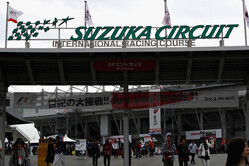


04/10/2018
NEWS STORY
 Ahead of this year's Japanese Grand Prix, new double kerbs have been installed on the exit of Turns 13 and 14, while tyres, with tube inserts, and additional conveyor belts have been installed in sections of the tyre barriers around the outside of Turns 2, 5, 7, 8 and 15.
Ahead of this year's Japanese Grand Prix, new double kerbs have been installed on the exit of Turns 13 and 14, while tyres, with tube inserts, and additional conveyor belts have been installed in sections of the tyre barriers around the outside of Turns 2, 5, 7, 8 and 15.
There is just one DRS zone, and it is located on the main straight. The detection point is 50m before Turn 16 and the activation point is 100m before the control line.
Pirelli has nominated the medium, soft and supersofts, with this specific combination already selected four times this season.
This is to cope with the notoriously high-energy demands of the circuit, with long and sweeping corners such as 130R and Spoon.
In fact, the cars are almost constantly cornering at Suzuka, with a relentless flow that makes the Japanese circuit one of the most-loved on the entire calendar.
Although the tyre selection is nominally the same as last year, in reality it's a step softer as all the compounds are one step softer compared to their 2017 equivalents.
The rhythm of the circuit, with its fast corners, means that Suzuka is all about lateral forces, rather than traction and braking. Also, the weather is often unpredictable at this time of year, with frequent rain: one of the factors that make track evolution quite hard to forecast.
Wear and degradation is traditionally high: some of the biggest energy loads of the year are put through the tyres.
Teams tend to run high downforce, pushing down on the tyres, in order to maximise grip. This means that the tyres are subjected to multi-directional forces at the same time.
Last year, a one-stopper proved to be the winning strategy, partly influenced by a safety car and virtual safety car, which are not uncommon in Japan.
Suzuka is one of the toughest circuits of the year for the Internal Combustion Engine (ICE). The sustained bursts of throttle test the internals' strength, while the heavy braking events challenge reactivity and reliability.
Over 65% of the lap is taken at full throttle, but the majority of this comes in the second half of the track from the exit of the Spoon corner (Turn 14) to the chicane on the entry of the pit straight. This includes 130R, which is taken at over 186 mph (300 km/h) despite being a flowing left hand bend.
With a top speed peaking at almost 205 mph (330 km/h), Suzuka gives rise to one of the highest speeds seen in the second part of the year. Inside the ICE the pistons will turn at an incredible 200 times per second, generating enormous internal forces.
The second slowest corner is the chicane, which is taken at approximately 50 mph (80 km/h). This is the best chance to recover energy through the MGU-K as the cars approach at well over 192 mph (310 km/h). Braking down to under 62 mph (100 km/h) generates huge amounts of heat and energy in the brakes. At this point there is even excess energy that engineers are not allowed to recover as a result of the regulations.
Last year's race was won by Lewis Hamilton, who ran a one-stop strategy, starting on supersofts before switching to softs, a strategy used by nine of the first twelve finishers, thirteenth-placed Pierre Gasly being the highest finisher to make two stops.
Michael Schumacher is the most successful driver at the Japanese Grand Prix with six victories, winning for Benetton in 1995 and Ferrari in 1997, 2000, 2001, 2002 and 2004. Second on the list are current drivers Sebastian Vettel and Lewis Hamilton, both of whom have four wins.
McLaren is the most successful team with nine victories. Two of those victories were, however, at Fuji, James Hunt's 1977 win at the track being scored 30 years prior to Hamilton's. At Suzuka McLaren are tied with Ferrari on seven wins each.
Hamilton and Fernando Alonso are the only drivers to have scored Japanese Grand Prix victories at two different venues. The first of Hamilton's four wins in Japan was scored at 2007 at Fuji, with McLaren, while the others came at Suzuka in 2014, 2015 and 2017, with Mercedes. Alonso won at Suzuka in 2006 and then at Fuji in 2008, both with Renault.
Apart from Hamilton, Vettel and Alonso, Kimi Raikkonen is the only other current driver with a Japanese Grand Prix win to his name. The Finn won in 2005 for McLaren.
Statistically, pole position is not crucial at Suzuka. In its 29 grands prix to date, the man on pole has won 14 times. Second position on the grid has yielded victory 11 times. Only Raikkonen has won from further back than sixth on the grid. He scored his 2005 victory from a starting place of P17.
This weekend, Alonso will take sole ownership of second place on the list of drivers with the most F1 starts. Sunday will be his 307th F1 start and will move him one ahead of Michael Schumacher and Jenson Button. Rubens Barrichello holds the record, with 322 starts.
Check out our Thursday gallery from Suzuka, here.